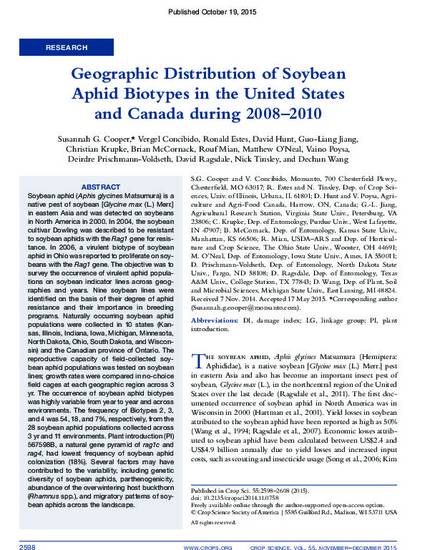
Soybean aphid (Aphis glycines Matsumura) is a native pest of soybean [Glycine max (L.) Merr.] in eastern Asia and was detected on soybeans in North America in 2000. In 2004, the soybean cultivar Dowling was described to be resistant to soybean aphids with the Rag1 gene for resistance. In 2006, a virulent biotype of soybean aphid in Ohio was reported to proliferate on soybeans with the Rag1 gene. The objective was to survey the occurrence of virulent aphid populations on soybean indicator lines across geographies and years. Nine soybean lines were identified on the basis of their degree of aphid resistance and their importance in breeding programs. Naturally occurring soybean aphid populations were collected in 10 states (Kansas, Illinois, Indiana, Iowa, Michigan, Minnesota, North Dakota, Ohio, South Dakota, and Wisconsin) and the Canadian province of Ontario. The reproductive capacity of field-collected soybean aphid populations was tested on soybean lines; growth rates were compared in no-choice field cages at each geographic region across 3 yr. The occurrence of soybean aphid biotypes was highly variable from year to year and across environments. The frequency of Biotypes 2, 3, and 4 was 54, 18, and 7%, respectively, from the 28 soybean aphid populations collected across 3 yr and 11 environments. Plant introduction (PI) 567598B, a natural gene pyramid of rag1c and rag4, had lowest frequency of soybean aphid colonization (18%). Several factors may have contributed to the variability, including genetic diversity of soybean aphids, parthenogenicity, abundance of the overwintering host buckthorn (Rhamnus spp.), and migratory patterns of soybean aphids across the landscape.
Available at: http://works.bepress.com/matthew_oneal/177/

This article is published as Cooper, Susannah G., Vergel Concibido, Ronald Estes, David Hunt, Guo-Liang Jiang, Christian Krupke, Brian McCornack et al. "Geographic distribution of soybean aphid biotypes in the United States and Canada during 2008–2010." Crop science 55, no. 6 (2015): 2598-2608. doi: 10.2135/cropsci2014.11.0758.